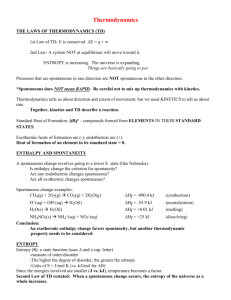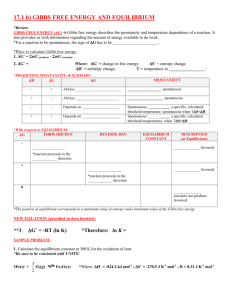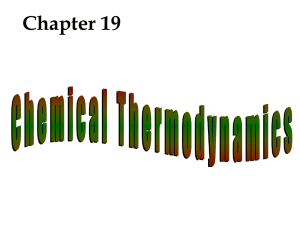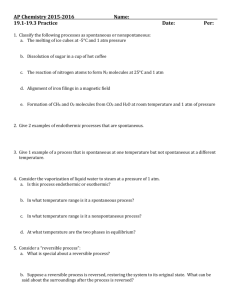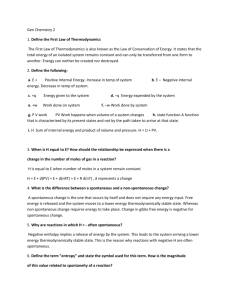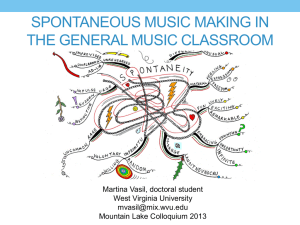MS Word
advertisement
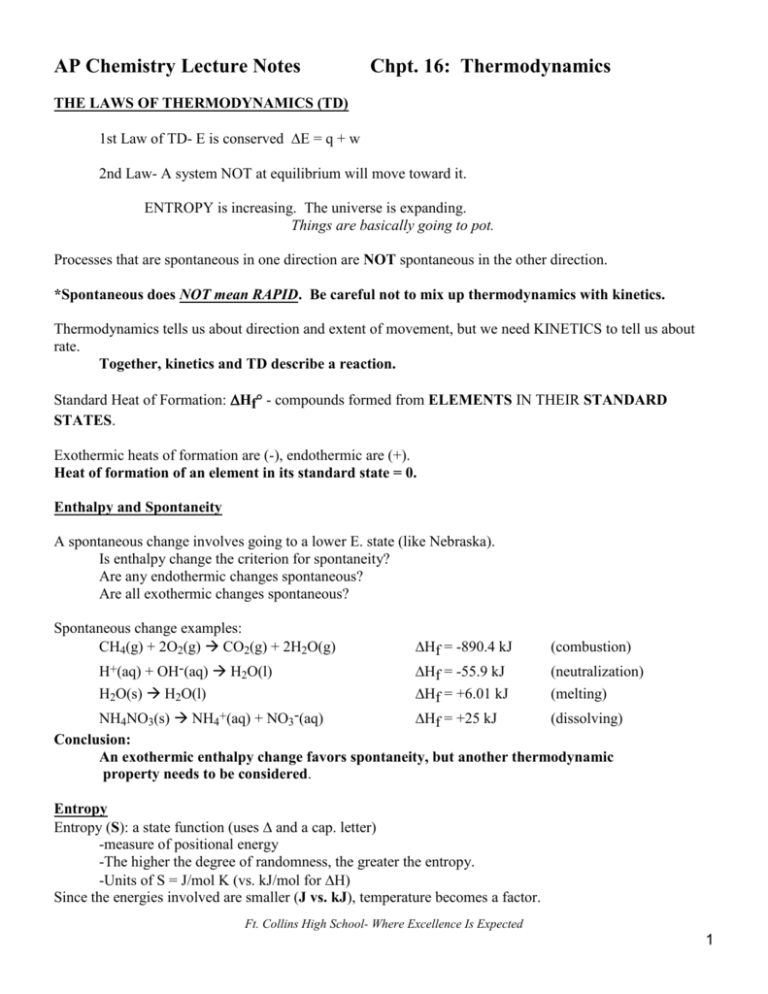
AP Chemistry Lecture Notes Chpt. 16: Thermodynamics THE LAWS OF THERMODYNAMICS (TD) 1st Law of TD- E is conserved E = q + w 2nd Law- A system NOT at equilibrium will move toward it. ENTROPY is increasing. The universe is expanding. Things are basically going to pot. Processes that are spontaneous in one direction are NOT spontaneous in the other direction. *Spontaneous does NOT mean RAPID. Be careful not to mix up thermodynamics with kinetics. Thermodynamics tells us about direction and extent of movement, but we need KINETICS to tell us about rate. Together, kinetics and TD describe a reaction. Standard Heat of Formation: Hf° - compounds formed from ELEMENTS IN THEIR STANDARD STATES. Exothermic heats of formation are (-), endothermic are (+). Heat of formation of an element in its standard state = 0. Enthalpy and Spontaneity A spontaneous change involves going to a lower E. state (like Nebraska). Is enthalpy change the criterion for spontaneity? Are any endothermic changes spontaneous? Are all exothermic changes spontaneous? Spontaneous change examples: CH4(g) + 2O2(g) CO2(g) + 2H2O(g) H+(aq) + OH-(aq) H2O(l) H2O(s) H2O(l) Hf = -890.4 kJ Hf = -55.9 kJ Hf = +6.01 kJ (combustion) (neutralization) (melting) NH4NO3(s) NH4+(aq) + NO3-(aq) Hf = +25 kJ (dissolving) Conclusion: An exothermic enthalpy change favors spontaneity, but another thermodynamic property needs to be considered. Entropy Entropy (S): a state function (uses and a cap. letter) -measure of positional energy -The higher the degree of randomness, the greater the entropy. -Units of S = J/mol K (vs. kJ/mol for H) Since the energies involved are smaller (J vs. kJ), temperature becomes a factor. Ft. Collins High School- Where Excellence Is Expected 1 Second Law of TD restated: When a spontaneous change occurs, the entropy of the universe as a whole increases. The driving force of any spontaneous change is an increase in the entropy of the universe. There is a drive toward the states that have the highest probability of existing. Example: Why does a gas spontaneously expand into an evacuated container? Zumdahl. There are many more possible ways that the molecules of gas can have equal numbers of molecules in each container than there are that all the molecules be in just one of the 2 connected containers. If we look at a simple system involving just a few molecules, we can examine the microstates and see what this means. If we only had one molecule in the system, there would be a ½ probability of finding the molecule in either chamber. This probability exists for each molecule in the system. With 2 molecules in the system, the probability of finding them both in one chamber is ½ x ½ or ¼. So, there is only a 1 in 4 chance of finding both molecules in the left chamber. If we had 3 molecules, there would be a ½ x ½ x ½ = (1/2)3 or 1/8 chance of finding all 3 in the left chamber. With 10 molecules, there is only a (½)10 or 1 in 1024 chance of finding all 10 molecules in the left chamber. While not impossible, it is highly improbable that these randomly moving gas molecules would all find themselves in the left chamber at the same time. On the other hand, there are hundreds of ways of having 4 and 6, or 5 molecules in each chamber. Systems will move toward the state with the most possible arrangements or the highest probability of existing. Third Law of TD: the entropy of a pure crystalline substance at absolute zero is zero. ie: S (at 0 K) = 0 Entropy changes: Ssys = Sfinal - Sinitial ( is always final - initial) Or, Ssys = (Sproducts) – (Sreactants) S > 0 (S = +) means disorder is increasing, system becoming more random (particles are moving faster or spreading out). S < 0 (S = -) means randomness is decreasing, system getting more organized. S > 0 is thermodynamically favorable. Ft. Collins High School- Where Excellence Is Expected 2 Disorder can be reduced by E input. You and other living things are a good example of this. Without E, you would die and, like Mozart, begin to decompose, and become more random. Suniverse = Ssystem + Ssurroundings Note: Ssystem being + increases the chance of Suniverse being + also, thus favoring spontaneity. The Ssurr depends directly on heat flow and inversely on temperature of the surroundings. Heat flow to the surroundings increases molecular movement in the surroundings and therefore the randomness of the surroundings: entropy increases (+Ssurr). Likewise, endothermic processes draw heat from the surroundings and give -Ssurr. However, the same amount of heat flow to the surroundings has a much greater impact at low temperatures than at high temperatures. So Entropy driving force = magnitude of entropy change of the surroundings = quantity of heat (J)/ temperature (K). Or, Ssurr = -H/T. So, knowing this information, it is possible to calculate Suniv. Suniv = [(Sproducts) – (Sreactants)] + [-H/T] = Ssystem + Ssurroundings Entropy Changes for Physical Phase Changes For a given substance: S(s) < S(l) < S(g) For freezing (l s) S = S(s) - S(l), S = (-), more order. Heat must be given off (or removed) for this process to occur. The heat to the surroundings increases the molecular movement of the surroundings, increasing Ssurroundings. Entropy Changes for Chemical Reactions 1. NH3(g) + HCl(g) NH4Cl(s) 2. 2O3(g) 3O2(g) 3. H2(g) 2H(g) 4. Ag+(aq) + Cl-(aq) AgCl(s) S = (-) gas to solid S = (+) more moles of gas S = (+) more moles of gas S = (-) solid more ordered than (aq) ions **S increases as 1. volume increases. 2. particle motility increases (s l g), or as T increases, or as particles dissolve. Calculating S°rxn (° = standard TD conditions, 1 atm, 25°C, 1M sln) S°rxn = Σ S°prod. - Σ S°react. (p. A20 in text book) S° = absolute entropy of a substance at 25°C (can be calculated based on the fact that S° = 0 at 0 K) *S° for an element in its standard state is NOT zero. (No element has a standard state defined where T = 0 K.) The Two Factors Affecting Spontaneity Ft. Collins High School- Where Excellence Is Expected 3 1. Tendency to go to a lower enthalpy. 2. Tendency to go to a higher entropy. Bringing H and S together to predict spontaneity: Gibbs Free Energy (G) G = H - TS Since we can't know absolute H, we can't get absolute G. We therefore define a new TD function for the system, free energy, which allows us to predict spontaneity: G = H - TS G = E free to do useful work H = change in heat content (enthalpy) TS = E associated with changing order/disorder Two Ways to Calculate Gorxn 1. Use G°rxn = H° - TS° where T = 298 K (25°C), with, if necessary H°rxn = Σ H°prod - Σ H°react and S°rxn = Σ S°prod - Σ S°react 2. Use G°rxn = Σ G°f prod - Σ G°f react G°f for an element in its standard state is 0 kJ/mol. Relationship between G° and spontaneity: G° = (-), spontaneous exergonic G° = 0, equilibrium G° = (+), nonspontaneous endergonic What Does Spontaneous or Nonspontaneous Mean? 1. Physical change: if spontaneous, these go to completion, 100% change. There is no tendency for an ice cube to stop melting at 10°C. H2O(s) H2O(l) at 10°C. 2. Chemical reactions: Spontaneous means a reaction that gives predominantly products. The system may reach equilibrium, the right side will be favored. Nonspontaneous does not mean "no reaction." Here, spontaneous, non-spontaneous does not mean "go or no go." Nonspontaneous means the reaction mixture is mostly reactants. Nonspontaneous reactions can be made to occur by use of an outside E source. Ex. electrolysis of water and other electrolytic rxns. Qualitative Relationship Between G° and Position at Equilibrium 1. When G° is (-) The more (-) the G°, the higher the % rxn. Large -G° rxns go more toward completion than low -G° rxns. Ft. Collins High School- Where Excellence Is Expected 4 Reactants are always higher than products, but the bottom of the curve skews left or right between 50 and 100%. 2. When G° is (+) The more (+) the G°, the lower the % rxn. Reactants are always lower than products, but the bottom of the curve skews left or right between 0 and 50%. The more (-)G°rxn , the higher the % completion of the rxn at 25°C. The more (+)G°rxn , the lower the % completion of the rxn at 25°C. Rxns that are nonspontaneous in one direction will be spontaneous in the other. Also, remember that conditions will often not be standard. (See next section.) Relationship Between G, Equilibrium Expressions and Reaction Quotients G = G° + RTlnQ (or G = G° + 2.303RTlogQ) Please note this equation has Q, not K. G° = standard free E change (standard conditions: P= 1 atm, [ ] = 1M, T = 25°C or 298K) G = free E under any conditions. T = temp on Kelvins Q = rxn quotient, from the equilibrium constant equation. -gases represented by pressure -aqueous solutions represented by molar conc. R = 8.314J/mol K If conditions are NOT standard, G must be calculated, NOT G°. Ft. Collins High School- Where Excellence Is Expected 5 G changes as the reaction proceeds, with changes in Q. Driving forces (H and S) change until equilibrium is achieved. At equilibrium, G = 0, and Q = K. G is a true measure of spontaneity under any conditions. At equil., G = 0 = G° + RTlnK, therefore G° = -RTlnK A frequently confusing issue results from the fact that G° implies 25C (298K), however G° may be calculated for other temperatures. The position of equil is related to G°. If K > 1, G° is (-), mostly product and spontaneous If K = 1, G° = 0, system at equilibrium If K < 1, G° = (+), mostly reactants and nonspontaneous. Ex. dissociation of acetic acid is thermodynamically nonspontaneous. A 0.1M sln is 97% molecules and only 3% ionized, K = 1.8 x 10-5. This doesn't mean that there is NO reaction, but products are not favored. 1. When all reactants and products are spp. in sln, K = Kc, c = [ ] in M. 2. When all reactants and products are gases, K = Kp, p = pressure in atm. 3. When mixtures of gases and aq. spp. are present, K is neither Kc nor Kp, but is simply a thermodynamic K: K = Kthermodynamic. The Effect of Temperature on Spontaneity H° and S° are virtually temp. independent. So, G = H° - T S° can be used to calculate G at any temp. Temp is considered in T S°. **Note, there is no"°" on G. H° S° G Comments/Examples 1. + - at all temps. Spontaneous. Ex. nitroglycerine 2. - - - at low temps. + at high temps. As T increases, T S° > H°, so H° usually larger, kJ/mol vs. J/mol for S° 3. + + + at low temps. - at high temps. Ex. ice doesn't melt at -10°C. ice does melt at +10°C. 4. + - + at all temps. Nonspontaneous under all conditions Situations 2 and 3 where the signs for H° and S° are ALIKE are temp dependent. Situations 1 and 4, where the signs are OPPOSITE are not temp. dependent. Calculating the Temperature at Which a Reaction Becomes Spontaneous/Nonspontaneous. Temp range of spontaneity: 1. Determine G at 25°C, i.e. G°. Ft. Collins High School- Where Excellence Is Expected 6 2. Determine the temp at which G = 0 (equilibrium). 3. Predict whether the rxn is spontaneous or not above that temp. Ex. N2O4(g) ⇄ 2NO2(g) H° = (2Hf° NO2) - (Hf° N2O4) = +58 kJ S° = (2Sf° NO2) - (Sf° N2O4) = +176.6 J/K The signs are alike. At a glance we would suspect this rxn to be nonspontaneous at low temps, spontaneous at higher temps. 1. G° = H° - TS° G at 25°C = 58,000J - (298K x 176.6 J/K) = +5.4 x 103 J +G = nonspontaneous at 25°C Reactant N2O4 favored, eq lies to the left, K < 1. 2. Solve for G = 0 = H° - TS° H° = TS° so, T = (H°/S°) = (58,000J/176.6J/K) = 328K At 328K, the system is at equil, not spontaneous in either direction. 3. +5.4 x 103 J at 298K, 0 J at 328K G will be (-) at T > 328K, spontaneous at temps above 328K Ex. CaCO3 (s) CaO(s) + CO2(g) H° = +178.3 kJ S° = +160.5 J/K This process becomes spontaneous at a higher temp (1110 K, 837°C). This is good, otherwise all marble, limestone and chalk would disintegrate. *NOTE: For physical phase changes, G = 0 for all phase changes at the normal temp of the phase change (m.p. or b.p). 0 = H° - TS°, T = (H°/S°) calculates the temp of a phase change. If this is done for water, T = 370K vs the true value of 373K. H° and S° are for standard conditions. If we calculate G = 0 in this way at a temp. NOT = 25°C, (ex. water melts at 0°C), H and S are very slightly different than H° and S°. The temperatures calculated for spontaneity may also be off a bit for this same reason. Ft. Collins High School- Where Excellence Is Expected 7
